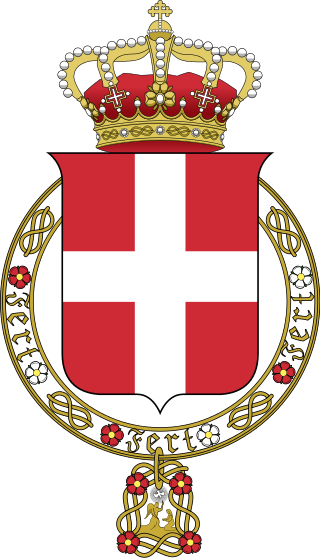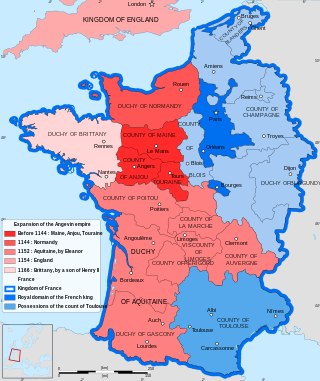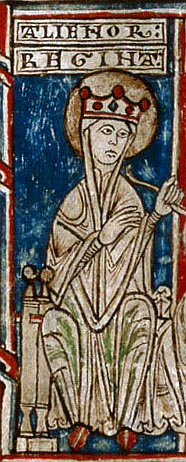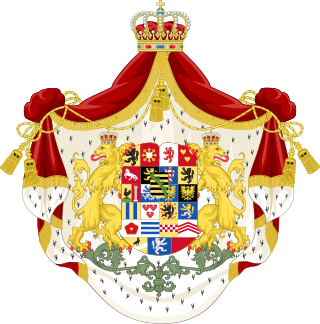
The House of Habsburg, also known as the House of Austria, was one of the most prominent and important dynasties in European history.

The House of Hohenzollern is a formerly royal German dynasty whose members were variously princes, electors, kings and emperors of Hohenzollern, Brandenburg, Prussia, the German Empire, and Romania. The family came from the area around the town of Hechingen in Swabia during the late 11th century and took their name from Hohenzollern Castle. The first ancestors of the Hohenzollerns were mentioned in 1061.

The House of Este is a European dynasty of North Italian origin whose members ruled parts of Italy and Germany for many centuries.

Duke is a male title either of a monarch ruling over a duchy, or of a member of royalty, or nobility. As rulers, dukes are ranked below emperors, kings, grand princes, grand dukes, and sovereign princes. As royalty or nobility, they are ranked below princes and grand dukes. The title comes from French duc, itself from the Latin dux, 'leader', a term used in republican Rome to refer to a military commander without an official rank, and later coming to mean the leading military commander of a province. In most countries, the word duchess is the female equivalent.

The House of Savoy is an Italian royal house that was established in 1003 in the historical Savoy region. Through gradual expansions the family grew in power, first ruling a small Alpine county northwest of Italy and later gaining absolute rule of the Kingdom of Sicily. During the years 1713 to 1720, they were handed the island of Sardinia and would exercise direct rule from then onward.

Gascony was a province of the southwestern Kingdom of France that succeeded the Duchy of Gascony (602–1453). From the 17th century until the French Revolution (1789–1799), it was part of the combined Province of Guyenne and Gascony. The region is vaguely defined, and the distinction between Guyenne and Gascony is unclear; by some they are seen to overlap, while others consider Gascony a part of Guyenne. Most definitions put Gascony east and south of Bordeaux.

The duke of Aquitaine was the ruler of the medieval region of Aquitaine under the supremacy of Frankish, English, and later French kings.

Eleanor of England, was Queen of Castile and Toledo as the wife of Alfonso VIII of Castile. She was the sixth child and second daughter of Henry II, King of England, and Eleanor of Aquitaine. She served as Regent of Castile during the minority of her son Henry I for 26 days between the death of her spouse and her own death in 1214. Her great-granddaughter and namesake, Eleanor of Castile, married the future Edward I of England in 1254.
Duke of Burgundy was a title used by the rulers of the Duchy of Burgundy, from its establishment in 843 to its annexation by the French crown in 1477, and later by members of the House of Habsburg, including Holy Roman Emperors and kings of Spain, who claimed Burgundy proper and ruled the Burgundian Netherlands.

The Duchy of Aquitaine was a historical fiefdom located in the western, central and southern areas of present-day France, south of the river Loire. Although the full extent of the duchy, as well as its name, fluctuated greatly over the centuries and at times comprised much of what is now southwestern (Gascony) and central France.
The County of Armagnac, situated between the Adour and Garonne rivers in the lower foothills of the Pyrenées, was a historic county of the Duchy of Gascony, established in 601 in Aquitaine. In 960, the title of 'Count of Armagnac' was established, and thus the County of Armagnac was created. In 1751, following the death of childless Charles de Lorraine, Comte d'Armagnac, the county was absorbed into the Crown lands of France and the King, then Louis XV took the title of 'Count of Armagnac'. In 1791, following the decree dividing France into departments, the county was disestablished, but remains an important natural region of France.

Segorbe is a municipality in the mountainous coastal province of Castelló, autonomous community of Valencia, Spain. The former Palace of the Dukes of Medinaceli now houses the city's mayor. Segorbe's bull-running week in September attracts 200,000 visitors each year.

Bigorre is a region in southwest France, historically an independent county and later a French province, located in the upper watershed of the Adour, on the northern slopes of the Pyrenees, part of the larger region known as Gascony. Today Bigorre comprises the centre and west of the département of Hautes-Pyrénées, with two small exclaves in the neighbouring Pyrénées Atlantiques. Its inhabitants are called Bigourdans.

The House of Saxe-Coburg and Gotha is a European royal house. It takes its name from its oldest domain, the Ernestine duchy of Saxe-Coburg and Gotha, and its members later sat on the thrones of Belgium, Bulgaria, Portugal, and the United Kingdom and its dominions.

Prince Albert Casimir of Saxony, Duke of Teschen was a Saxon prince from the House of Wettin who married into the Habsburg imperial family. He was noted as an art collector and founded the Albertina in Vienna, one of the largest and finest collections of old master prints and drawings in the world.
William II Sánchez, Duke of Gascony from circa 961 at least until 996, was the younger illegitimate son of duke Sancho IV and successor, around 961, of his childless elder brother, Duke Sancho V. He united the County of Bordeaux with the Gascony. Documents of his reign state that his grandfather came from Iberia, lending credence to "phantasmagorical" genealogies placing the origins of García II Sánchez across the Pyrenees. He died in 996 or 997 and was succeeded by his son, Bernard William.

The Duchy of Gascony or Duchy of Vasconia was a duchy located in present-day southwestern France and northeastern Spain, an area encompassing the modern region of Gascony. The Duchy of Gascony, then known as Wasconia, was originally a Frankish march formed to hold sway over the Basques. However, the duchy went through different periods, from its early years with its distinctively Basque element to the merger in personal union with the Duchy of Aquitaine to the later period as a dependency of the Plantagenet kings of England.

The House of Bourbon-Parma is a cadet branch of the Spanish royal family, whose members once ruled as King of Etruria and as Duke of Parma and Piacenza, Guastalla, and Lucca. The House descended from the French Capetian dynasty in male line. Its name of Bourbon-Parma comes from the main name (Bourbon) and the other (Parma) from the title of Duke of Parma. The title was held by the Spanish Bourbons, as the founder Philip, Duke of Parma was the great-grandson of Ranuccio II Farnese, Duke of Parma. The House of Bourbon-Parma is today the Sovereign House of the Grand Duchy of Luxembourg (agnatically) and all members of the Grand Ducal Family of Luxembourg are members of the House of Bourbon-Parma with the title of "Princes/Princesses" and the predicate of Royal Highness.

The House of Montcada is an aristocratic and noble Spanish Catalan House with important ramifications in Sicily. Queen Elisenda of the Crown of Aragon was a member of the family.

The House of Lecubarri was an ancient noble family, possibly a cadet branch of the House of Poitiers, through Bernard William I. The etymology of the name comes from the words lek(h)u (place) and barri (new), meaning "new place" in the Basque language of the north of Spain. The House has transmitted its status of nobility since time immemorial.

















